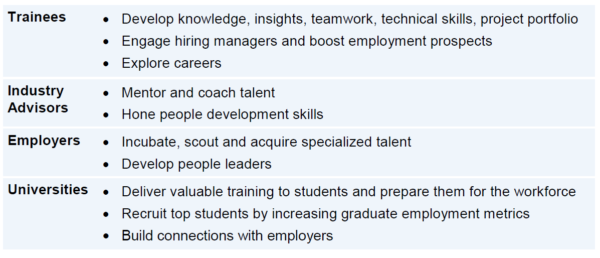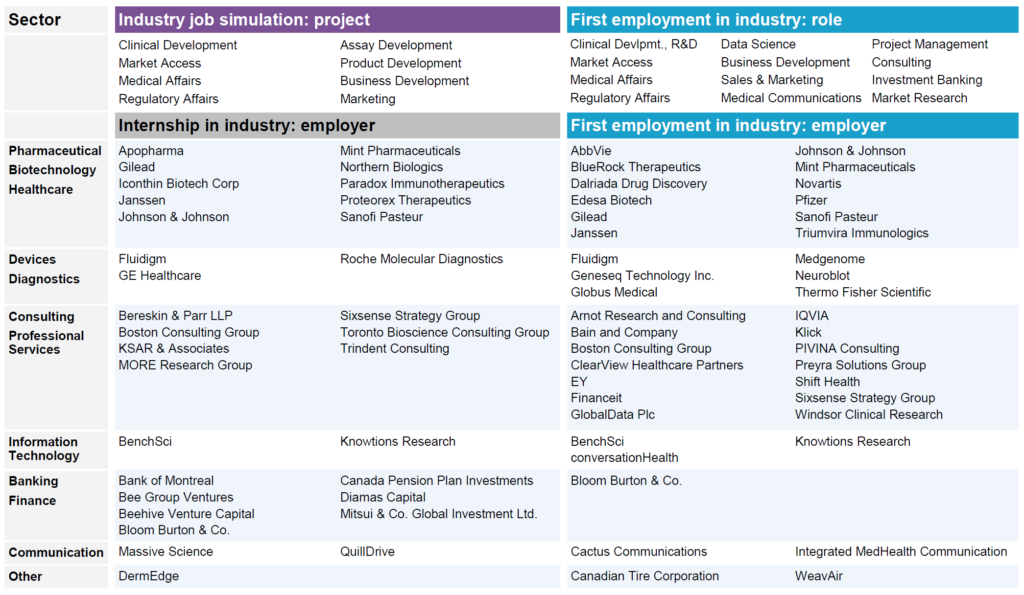Developing an Industry Job Simulation Program for Graduate and Postdoctoral Trainees in Life Sciences
By Katelyn Kozma, Anne Meyer-Miner, Jonathan Chio, Stefanie Mak, Ahmed El-Boraie and David Sealey
The previous ITCS team leads have published an article summarizing how to develop Job Simulation programs that enable trainees to gain relevant experience for industry careers. In addition, David Sealey, Anne Meyer-Miner, and Katelyn Kozma have created a poster Employment Outcomes of Life Science Industry Job Simulation Program Alumni at the University of Toronto—Where are They Now? that references this article as well as summarizes the impact of the ITCS program by tracing alumni (see details below).
Challenge
Life science graduate trainees may not be competitive in the industry job market if they do not have knowledge, skills and experience that employers can relate to
Experiential learning, including job simulation, can help trainees prepare themselves for the job market
Job Simulation Program @ Univ. of Toronto: Industry Team Case Study (ITCS)
Trainees (graduate students, postdoctoral fellows) work in teams on simulated industry projects with mentorship from professionals
Trainees
Identify a business or policy challenge
Conduct research and analysis
Propose a solution to address the problem
Present their findings to industry professionals
Mentors provide feedback on proposed topics and quality of the work, and explain complex aspects of their field
Program developed and operated by Science Career Impact Project and Life Sciences Career Development Society
Sector of first employment after completing degree/fellowship
184 trainees participated in the job simulation program from 2016 to 2020 (p4)
As of Jan. 2021, 55% (58/106) of the trainees who had graduated / completed training were first employed in industry
Historical benchmark: 951 life science PhD graduates from 2012 to 2015; in 2016, 20% were employed in private sector (industry); see Methods (p4)
Job simulation program benefits
Paths to employment in industry
58 alumni graduated / completed training after the Industry Team Case Study job simulation and were first employed in industry
Many trainees pursued other development activities including internships in non-profit organizations and/or other training
>180 trainees participated in the job simulation program from 2016 to 2020
Methods
Publicly available data were retrieved from institutional sources (eg, University of Toronto Online Thesis repository, department websites), online networks (eg, LinkedIn) and other online sources (eg, PubMed) to identify training activities and employment outcomes of Industry Team Case Study job simulation program alumni
Data were current as of January 2021
To determine a historical benchmark rate for sector of employment, data were derived from the 10,000 PhDs Project, School of Graduate Studies, University of Toronto (Reithmeier et al. 2018. Retrieved March 25, 2021 from www.sgs.utoronto.ca/about/Pages/10,000- PhDs-Project.aspx). From 2012 to 2015, there were 951 PhD graduates in life sciences (Faculties of Medicine, Dentistry, Pharmacy, Public Health). Their employment as of 2016: post-secondary, 47%; private (industry), 20%; public, 18%; charitable, 4%; individual, 1%; unknown, 10%. These rates were not compared to the rates for the Industry Team Case Study alumni due missing data on potential confounding factors.
Conclusions
Life science job simulation program, internships and other training were associated with employment in industry
To prepare for industry employment, job simulation is an alternative or complement to an internship
Suggested Reading
Kozma, K., Meyer-Miner, A., Chio, J., Mak, S., El-Boraie, A., Sealey, D. (2021). Developing an industry job simulation program for graduate and postdoctoral trainees in the life sciences. Canadian Journal of Career Development. 20(2), 84-93. doi.org/10.53379/cjcd.2021.102
Sealey, D., Yung, A., Rinchon, C., Wehrle, C. (2020). Case studies give grad students a chance to tackle industry challenges. University Affairs. www.universityaffairs.ca/career-advice/career-advice-article/case-studies-give-grad-students-a-chance-to-tackle-industry-challenges/
Yung, A., Wehrle, C., Rinchon, C., Sealey, D. (2019). Getting hired in industry – life science graduate students use case studies to get noticed by employers. OSF Preprints. doi.org/10.31219/osf.io/x6fny
Her, S., Jacob, M., Wang, S., Xu, S., Sealey, D. (2018). Non-academic employability of life science PhDs: the importance of training beyond the bench. BioRxiv. doi.org/10.1101/485268
Freeman, M. (2017). How case studies can help to smooth the academy-to-industry transition. University Affairs. www.universityaffairs.ca/career-advice/career-advice-article/case-studies-can-help-smooth-academy-industry-transition/






